Wooden-hulled fishing boats of the Mergui Archipelago
Once again, we took our morning tea or coffee on deck as fishing vessels set off in various directions around us and the sun rose higher in the sky. Each ship was notably individual but perhaps we can distinguish some typical characteristics. The wooden-hulled boat shown at rest below (there's also a larger version of the image available) had a crew of six.
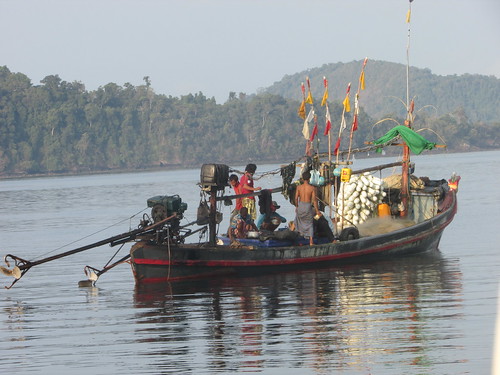 The Fishing Fleet at Nyaung Wee: A typical wooden-hulled drift net fishing vessel with two engines and 'long-tail' 2-blade propellors. Six crew can be seen.
The Fishing Fleet at Nyaung Wee: A typical wooden-hulled drift net fishing vessel with two engines and 'long-tail' 2-blade propellors. Six crew can be seen.Click here for a larger view.
Tied to the bow (on the right) a number of coloured scarves can be made out, with some cut flowers. These are presumably to propitiate the malign spirits, the 'Nats'. In Burma, belief in the 'Nats' co-exists with Buddhism. There is a square-section post near the bow which carries a series of drooping leaves, I assume again to please the 'Nats'. This post carries a cross-arm to support a covering (furled away in this picture). When extended towards a similar crossarm on a second square post, this covering provides some protection against the intense heat of the sun. The bow post also supports what appears to be a VHF radio antenna. On the foredeck, there's a large pile of white plastic moulded floats presumably attached to the top edge of a long fishing net arranged to hang vertically when deployed. The rather gay-looking flagpoles are attached to floats and and are intended to be attached to the fishing nets to assist finding the net again prior to hauling in a catch. Each flagpole has a battery-operated beacon near the top, no doubt invaluable when fishing at night. The deck is provided with an untidy string of electric light bulbs running fore-and-aft for use after dark, but I couldn't work out what provides the power. Elsewhere, large car batteries driving a solid-state inverter are common.
The crew can be seen towards the stern apparently finishing breakfast, in an area with a number of large moulded plastic boxes as used to store the 'catch'. Towards the stern, there's a shorter square post topped with a small 'table' which carries a moulded plastic fuel drum for diesel, which is fed to the engine through an uncertain-looking arrangement of flexible hoses.
The motive power is provided by a 'long tail' arrangement, common in Asia. The engine is mounted on the centreline of the hull above the sternpost on a pivoting and tilting frame. The engine spins a long propeller shaft carried in a tube with a propeller (in this case, a 2-blade propeller) at the far end, hence the name. The long propeller shaft is necessary to place the propeller at a reasonably shallow 'angle of attack' to the water for effective propulsion. The 'helmsman' controls the boat by physically manoeuvring the engine, lowering the propeller into the water for drive or lifting it clear as required.The propeller blades are protected by a steel rod 'bumper' welded underneath (a bit like a 'tail skid' on early aircraft) to prevent damage when operating in shallow water. Directional control is achieved by pivoting the whole engine and 'long tail' assembly left or right, producing 'thrust vectoring'. In Thailand, motor car engines frequently provide the motive power for 'long-tail' boats but, in Myanmar, I think I've only seen the rugged Chinese-made single cylinder compression-ignition (diesel) engines used, presumably a consequence of Myanmar's long period of isolation from Western markets. The exposed engine flywheel also drives a small water pump which lifts water from the sea, circulates it through the engine to provide cooling and expels it through a pipe attached to the long tube housing the propeller shaft. The end of this tube is shaped so that the water is discharged against the rear of the propeller blades, throwing up an impressive spray.
The boat illustrated, like many, also has a second, similar engine. I'm not sure whether this is to improve the top speed, increase reliability, improve manoeuvrability or for other reasons. The second engine is mounted on the gunwale (the strong top edge of the side of the boat) on the port (left) side a little forward of the stern on a separate pivoting and tilting frame.
The picture below shows a rather extreme example of this type of wooden-hulled boat, in this case provided with three 'long tail' engines.
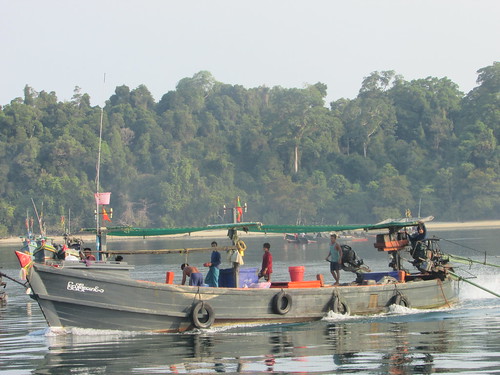 This extreme example of the wooden fishing vessel, seen leaving Nyaung Wee had three engines and long-tail propellers and a crew of seven.
This extreme example of the wooden fishing vessel, seen leaving Nyaung Wee had three engines and long-tail propellers and a crew of seven.Click here for a larger view.
Again, there are scarves and (rather dessicated-looking) flowers on the bow, on the left of the picture. There are three square-section vertical posts, this time all tall enough to carry a green sun-shade almost the full length of the deck. This green shade is deployed and securely tied in place with the usual string of electric light bulbs underneath. The post near the bow also supports a VHF radio antenna and, on a steel cross-arm, two navigation lights. The second square post also carries a steel cross-arm with two navigation lights, plus a small Myanmar National Flag. The post near the stern has a wooden platform carrying moulded plastic fuel drums for diesel and, above this platform, there's a small rectangular, permanent roof which is presumably a sun-shade for the fuel. Diesel has a much higher flashpoint than petrol, making it a much safer fuel from the point of view of flammability.
To provide motive power, the first engine is mounted on the centre line (being controlled by a man I take to be the 'Captain'), the second engine (which does not appear to be in use) is on the port side, a little ahead of the stern and a third engine is mounted on the starboard side, significantly further forward and being controlled by one of the crew.
Steel-hulled fishing boats of the Mergui Archipelago
A group of larger fishing vessels remained at anchor and, silhouetted against the sun, I thought they looked vaguely threatening.
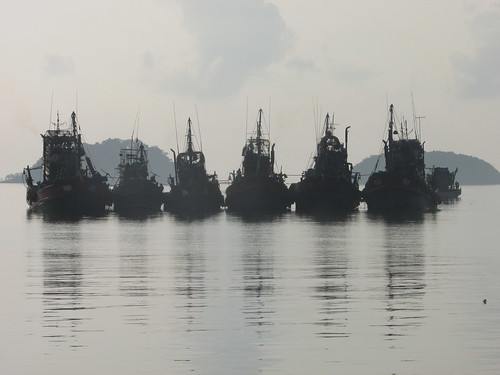 Larger fishing vessels anchored at Nyaung Wee.
Larger fishing vessels anchored at Nyaung Wee.
After we'd enjoyed a generous breakfast, our host said "Would you like to visit a fishing boat?" and we all enthusiastically said "Yes!" so, a little later, we all piled into the dinghy and I discovered that our destination was to be one of the larger vessels I'd photographed earlier. Now the sun was illuminating the boats, the sense of menace had gone but their size meant they were still imposing! These were steel-hulled vessels, which seemed intended for deep sea fishing. There were variations in design between the various ships: most were painted in a livery of grey, with the upper part of the hull in red. The bow of each boat carried the expected scarves: more puzzling was that the name of each vessel had been deliberately, but not completely effectively, obscured by a rectangle of material. An anti-fisheries protection measure? I wondered.
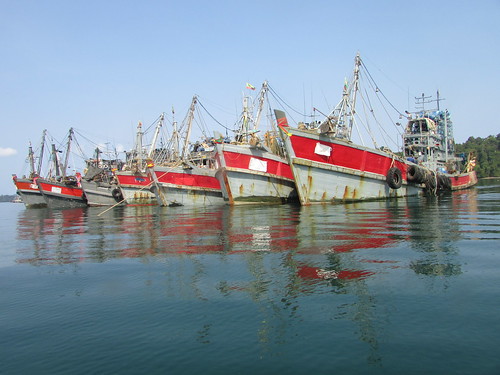 Visiting a fishing trawler.
Visiting a fishing trawler.
We approached the port side of the outside vessel of the group. The foredeck of the boat mounted a serious-looking derrick, with a derrick mast using 'stiff-leg' staying and a single boom (other vessels nearby also had derricks, but with the mast guyed). The top of the derrick mast carried the familiar series of drooping leaves and Myanmar National Flag. The 2-storey superstructure (with the wheelhouse at the forward end, deck level) extended towards the stern of the boat and, with the addition of extensive storage on the roof of the superstructure for a large number of moulded, plastic drums (I assumed for the 'catch'), the ship towered above us. At the stern, on both sides, large metal-bound wooden boards were stowed - 'otterboards' used to keep the open end of the large conical fishing net dragged behind a trawler from closing. This seemed to fit with the heavy-duty winch on the port side, just level with the wheelhouse (I assume that there was a second, similar winch on the starboard side) and the row of large tyres hanging from the port side level with the foredeck (to prevent damage to a 'side trawl' net being hauled aboard).
Our inflatable dinghy came alongside the hull and, with my impaired mobility, I thought "I wonder if this is completely wise?". A couple of my fellow-passengers climbed onto the deck successfully, so I thought I'd better try. Just to my left, I spotted a scupper in the hull of the vessel. 'Scuppers' are openings in the 'wall' ('bulwark') around the deck provided to allow water to drain off the deck and I realised that this opening offered a reasonable foothold. So I stood on the inflated tube forming the side of our dinghy, moved slightly to the left and with some difficulty managed to lift my left foot and wedge it into the aperture of the scupper. Reaching upwards, I grasped the steelwork and, with some effort (and, I think, with some assistance from behind) clambered onto the deck.
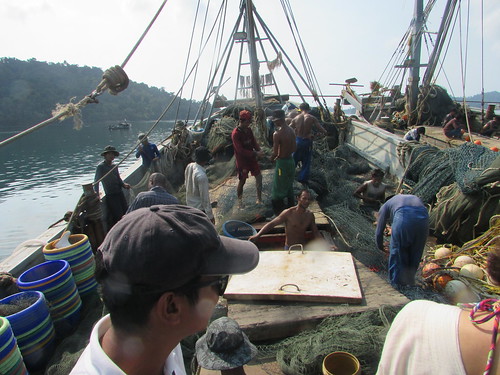 On board a moored fishing trawler at Nyaung Wee Island, Mergui Archipelago.
On board a moored fishing trawler at Nyaung Wee Island, Mergui Archipelago.
Every inch of deck seemed to be covered with green fishnet and I counted 12 men engaged in repairing the nets. In addition, I spotted what I took to be the Captain and Mate relaxing in the shade outside the wheelhouse. I took a picture of the 'net repair kit' - a number of plastic moulded shuttles, each loaded with a length of variously-coloured polypropylene rope.
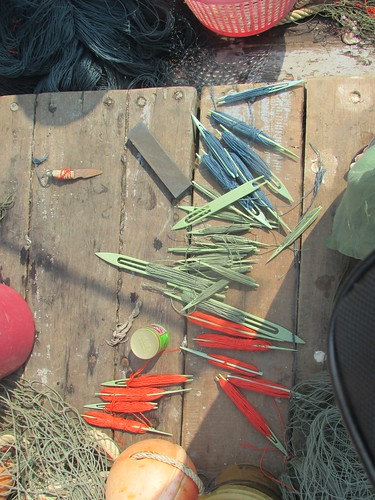
'Net repair kit'.
One of the men was standing in the hatchway to the forward hold, and he sorted a selection of decent-sized fish plus a number of the ubiquitous squid into a plastic bowl for us to take back to the cook on 'Meta IV', for which we paid with two trays of canned local beer. After watching the net repairing activities for a while and taking more photographs, it was time to leave the boat. By reversing the procedure I'd used to clamber aboard, I descended to our waiting dinghy without incident. When everybody was back on board, we headed back to 'Meta IV'.
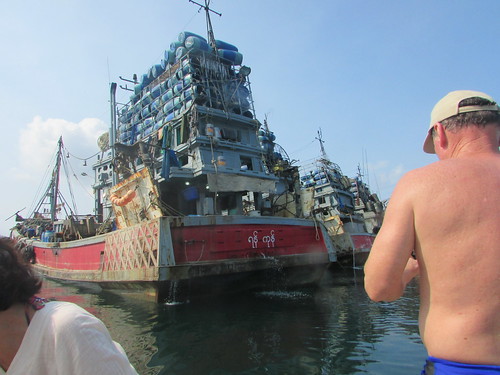 View of the stern of the fishing vessel we had just visited.
View of the stern of the fishing vessel we had just visited.
On our way back to our yacht, we paused briefly at one of the smaller wooden-hulled boats where the crew were happy to exchange more fish for cans of drink. While this transaction was in progress, the smiling captain relaxed near the bow, smoking a cigarette, shaded from the sun by the rather tattered roof covering.
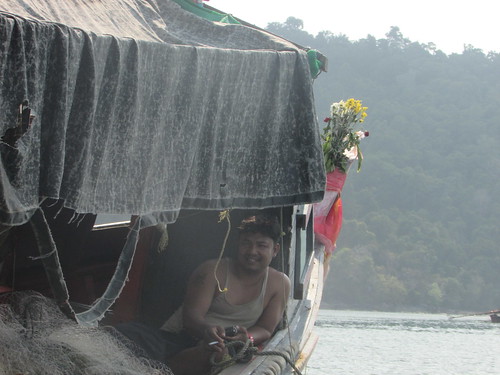 The captain of a smaller fishing boat relaxing. Note the coloured scarves and spray of flowers attached to the bow.
The captain of a smaller fishing boat relaxing. Note the coloured scarves and spray of flowers attached to the bow.
The mangrove forests of Lampi Island.
Once we were safely back on 'Meta IV' she set off north towards the the west coast of Lampi Island within Lampi Marine National Park, the only marine national park in Myanmar. There are two perennial rivers on Lampi Island and we anchored offshore near one of these, Lampi South River. Once again, we all piled into the dinghy for a cruise part of the way upstream on the river.
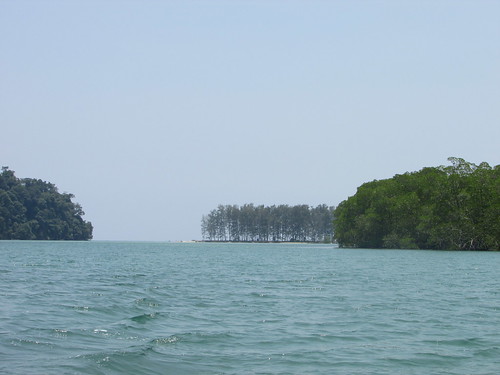 Looking back to the sea as we head upriver to the Mangrove Forest of Lampi South River.
Looking back to the sea as we head upriver to the Mangrove Forest of Lampi South River.
No riverbank was visible on either side - the vegetation overhung the water. As we continued, the elaborate the other-worldly root systems of mangrove appeared all around us - they give the trees the appearance that they are capable of walking. The complex adaptations provide filtration of the high salt levels possible in tidal areas and help resist the effect of wave action.
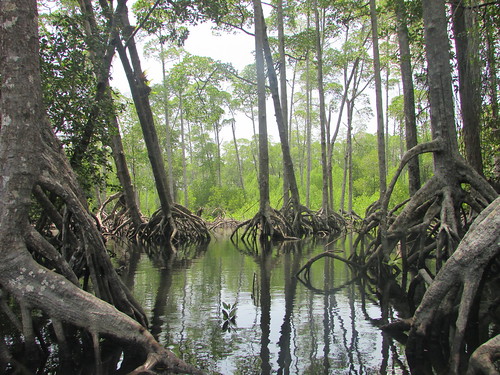 Mangrove Forest, Lampi South River.
Mangrove Forest, Lampi South River.
With the noisy outboard stopped, we were able to drift with the current for a while, emphasising the 'other-world' feel of these locations.
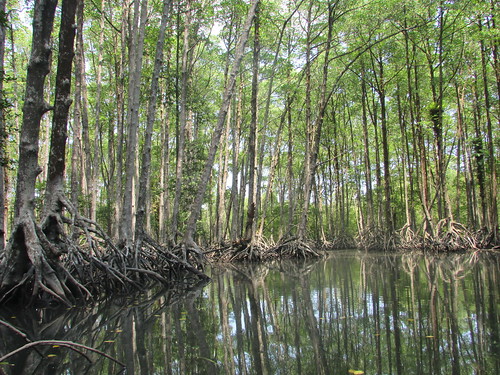 Mangrove Forest, Lampi South River.
Mangrove Forest, Lampi South River.
There's a Wikipedia article on mangroves here and I've written about visiting mangroves in the Asmat area of Indonesia here and at Bako National Park, Sarawak, Malaysia here.
Beach Visit to Island 60
After our fascinating trip by inflatable dinghy to Lampi South River, our ship continued northwards to a small, uninhabited island known, I believe, as 'Island 60' where another beach visit had been offered. Whilst we were preparing to go ashore by dinghy, we were passed by a group of local fishing boats. The wooden-hulled lead boat had a 'long tail' propulsion system and carried a Myanmar National Flag, allowing it to tow six dug-out canoes, each carrying one person. As far as I could make out, the motor boat held a man and woman, the towed boats carried an old woman, a girl, a boy, a woman, a man and another woman.
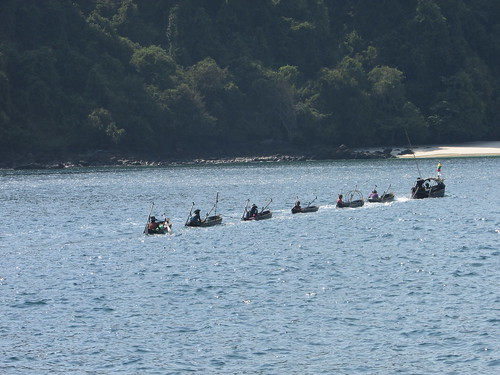 Local Fishing Boats near Island 60.
Local Fishing Boats near Island 60.
As I watched, the raft of seven boats passed a couple of stationary boats - a large dug-out fitted with a 'long tail' motor with one man aboard which had towed a smaller dug-out carrying a woman to their current position. By the time our dinghy has taken us ashore, there was no sign of the other boats and we were alone on a pristine beach allowing swimming, snorkelling and beachcombing.
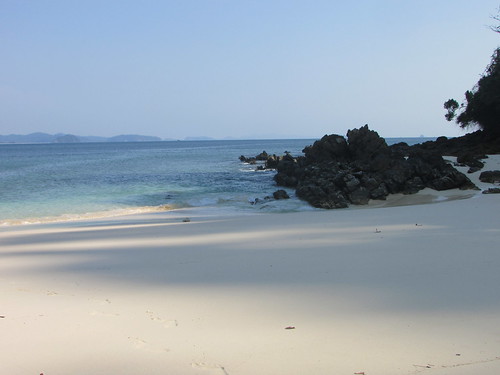 The Beach on Island 60.
The Beach on Island 60.
Ko Phaar Island and Hornbills
By the time we left the beach at Island 60, it was late afternoon but our host promised one more excursion by dinghy to see hornbills. We took the dinghy to a location a couple of hundred yards from the shore of the heavily-wooded island of Ko Phaar and waited as dusk darkened the sky. Before long, the distinctive silhouette of a hornbill was spotted, heading for Ko Phaar Island and passing overhead close to our position. I managed to capture a not-very-good image of this solitary bird.
 A single Hornbill returning to Ko Phaar Island.
A single Hornbill returning to Ko Phaar Island.
After a few minutes, three hornbills approached from a different direction. We were clearly in the right place, at the right time, for hornbills continued to appear, in ones, twos and threes, from various directions, heading for their overnight roosts high in the trees of Ko Phaar Island.
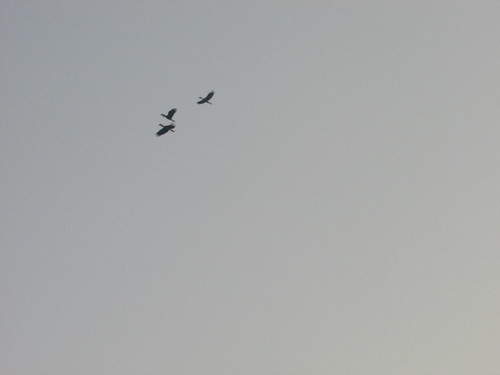 The Hornbills of Ko Phaar Island.
The Hornbills of Ko Phaar Island.
I'd seen the Hornbills in captivity elsewhere, (such as at Port Moresby Country Park, Papua New Guineau, as described here) but to see numerous birds in the wild, returning to roost on Ko Phaar Island, was a wonderful sight.
There's a Wikipedia article on this interesting family of birds here.
After a fairly intensive day, we returned to 'Meta IV' for another splendid dinner, after which I was quite ready to retire to my cabin.
Related posts
My report on the following day aboard 'Meta IV' can be found here.
All my posts on my trip to Myanmar in 2016 can be found here.
My pictures
Pictures in this article can be viewed uncropped by clicking on the image. To view in other resolutions or download, select from the albums below:-
The Fishing Fleet at Nyaung Wee
Visiting working fishing vessels.
Mangrove Forest.
The Beach on Island 60 and Fishing Boats.
Ko Phaar Island, Mergui Archipelago.
